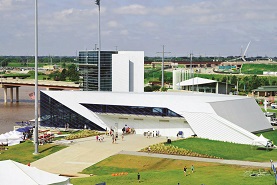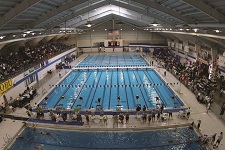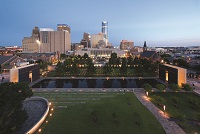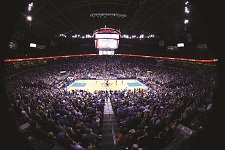
Maybe why that’s the area isn’t stereotyped as a powerhouse for just one sport – or even one type of sport – according to Sue Hollenbeck.
“It’s not that people have a preconceived notion of Oklahoma City, or that they have the wrong idea about it,” says Hollenbeck, the assistant director of sports business development for the Oklahoma City Convention & Visitors Bureau. “It’s more accurate to say that most people have a zero-baseline conceived idea. When they get here, they see all that we have and they are blown away.”
Now, the word is out and Oklahoma City continues to build on its reputation for hosting large-scale events on land and water, indoors and outdoors.
On the Waterfront
Oklahoma City has established itself as a rowing and kayaking destination, thanks in part to a special sales tax initiative. MAPS3, short for the Metropolitan Area Projects, was the third such tax undertaken by Oklahoma City; previous MAPS projects had funded revitalizations to the downtown area, as well as school facility improvements, technology and transportation projects.
 The waterfront, known in Oklahoma City as the Boathouse District, has grown exponentially, thanks to MAPS3; amenities such as a 70-foot-high finish line tower, four boathouses, spectator seating and more, make the area a Mecca for rowing and kayak events. Every year, athletes arrive in the city to train for and race in events at the regional, national and international levels. In late April, the Oklahoma City Boathouse Foundation and USA Canoe/Kayak will present the 2014 Flatwater Sprint Team Trials. The USA Rowing World Challenge, which came to the city in 2007 and 2011, will return in 2015.
The waterfront, known in Oklahoma City as the Boathouse District, has grown exponentially, thanks to MAPS3; amenities such as a 70-foot-high finish line tower, four boathouses, spectator seating and more, make the area a Mecca for rowing and kayak events. Every year, athletes arrive in the city to train for and race in events at the regional, national and international levels. In late April, the Oklahoma City Boathouse Foundation and USA Canoe/Kayak will present the 2014 Flatwater Sprint Team Trials. The USA Rowing World Challenge, which came to the city in 2007 and 2011, will return in 2015.
USA Canoe Kayak calls Oklahoma City home, and in 2009, the Oklahoma River and OKC Boathouse Foundation were named a U.S. Olympic & Paralympic Training Site, and the OKC National High Performance Center trains Olympic hopefuls in both rowing and canoe/kayak
The year 2015 will see the city break ground for a new whitewater course which, according to Hollenbeck, will have movable obstacles, adjustable water height and flow rate and more. And that, she notes, will put Oklahoma City in a unique position.
“We will be the only whitewater and flatwater venue in the United States, and maybe the world.” Along with the new whitewater course will come an increased number of restaurants and other attractions to support the uptick in sports business.
Take It Inside
Athletes whose performances are on dry land (but are punctuated with backflips and basket tosses – as well as bumps, sets and spikes, and other maneuvers) also find a warm welcome in Oklahoma City’s indoor facilities.
“We do a ton of cheerleading here,” notes Hollenbeck. “January and February are the big months for that. Between NCA (National Cheerleaders Association), the American Spirit Championships and the CheerForce Allstars, cheer just keeps getting bigger and bigger.”
 The Cox Convention Center is home to multiple cheer competitions. The facility features 100,000 square feet of exhibit space, a 25,000-square-foot ballroom, 21 meeting rooms and a 15,000-seat arena, all connected by a sky bridge to the Renaissance Oklahoma City Convention Center Hotel.
The Cox Convention Center is home to multiple cheer competitions. The facility features 100,000 square feet of exhibit space, a 25,000-square-foot ballroom, 21 meeting rooms and a 15,000-seat arena, all connected by a sky bridge to the Renaissance Oklahoma City Convention Center Hotel.
Other notable indoor facilities are Chesapeake Energy Arena (known best in the sports world as the home court of the Oklahoma City Thunder, with seating for 18,000), and the State Fairgrounds, the arena of which can hold 10,000 spectators.
Something else Oklahoma City has experience in hosting: volleyball. The wildly popular Redland Rendezvous draws an increasing number of high school-age teams each year. Coming soon will be a new FIVB-sanctioned center to be used by USA Volleyball for its training and competition purposes.
Wrestling is also big here. Oklahoma City is home to the NCAA Wrestling Championships in 2014, and Oklahoma City University was the first to offer a woman’s wrestling team.
“Sports here never really stops,” says Hollenbeck. Right before we go into the wrestling season, we’re hosting Big 12 Basketball.”
Playing the Field
Oklahoma City is the home of ASA Softball and USA Softball. This year, the ASA Hall of Fame Stadium will receive a much-needed makeover, including expanded spectator seating and new player amenities such as locker rooms. In addition, says Hollenbeck, the city hosts the NCAA Women’s World Series every year.
 Marathons, Triathlons and More
Marathons, Triathlons and More
The geography of Oklahoma City also lends itself to running and multisport events.
“We have the Oklahoma City Memorial Marathon, the IronKids Triathlon and the Redman Triathlon,” notes Hollenbeck.”
The swim portion of triathlons take place around Lake Hefner, with running and cycling on the adjacent trails and roads.
The Oklahoma City Memorial Marathon, taking place each April, was voted one of the 12 ‘must-run’ marathons in the world by Runner’s World magazine and commemorates the 168 lives lost in the bombing of the Alfred P. Murrah Federal Building bombing in 1995.
Swimming and Diving
The Aquatic Center at Oklahoma City Community College offers Olympic-caliber facilities for swimming and diving events.
Originally, the pool was built in as an outdoor venue and housed the aquatic events of the 1989 U.S. Olympic Festival. In 1991, the facility was renovated and enclosed and today, it boasts a 50-meter long, 25-meter wide pool with a four-foot wide movable bulkhead that allows organizers to transform the pool into a 25-yard short course. The pool also features a side ramp for ADA-compliant access. A separate diving well is equipped with two one-meter springboards, two three-meter springboards and platforms at five, seven and ten meters. Spectator capacity is 1,000 with additional seating for up to 500 athletes.
Outstanding Tennis
The Oklahoma City Tennis Center at Will Rogers Park has 24 courts, half of which have lighting for night play. There is also a stadium court (with seating for 200 spectators) for high-profile matches. Concession facilities are also available.
“Most of the high school tennis championships are held here,” says Hollenbeck. “In fact, they’re working on another eight courts, which will be indoors.”
 Extreme Sports in OKC
Extreme Sports in OKC
Those seeking facilities for cutting-edge sports can find them in Oklahoma City as well. The Oklahoma City Parks & Recreation Department offers three areas designed for skateboarding, BMX and skating at different skill levels. The Mat Hoffman Action Sports Park has both a flow course with bowls of various sizes, and a street course with ledges, handrails and more. The Route 66 Skate Court and the South Lakes Skate Court are designed for beginner to intermediate-level athletes.
The Mat Hoffman course, says Hollenbeck, is getting increased attention. “We are working more and more with USABMX to put on state and regional events.”
Wake Zone Cable Park, meanwhile, offers wakeboarding, waterskiing, kneeboarding and wakeskating.
After the Games
When the games are done, athletes, their families and friends can spend time exploring Oklahoma City’s vibrant downtown. The Bricktown district (another aspect of the MAPS initiative and formerly a warehouse area), has been transformed into a lively destination, bursting with restaurants, attractions, culture, music and more. The area offers something to competitors of all levels and all ages. For those wishing a quieter afternoon, Oklahoma City’s zoo, botanical gardens and even the American Banjo Museum are waiting.
Oklahoma City, for all its sights and attractions, has never lost sight of its Western heritage, and as a result, the National Cowboy & Western Heritage Museum is a must-see for many visitors.
“A lot of people don’t know that Oklahoma City has its own working stockyard,” says Hollenbeck. “There are cattle auctions every week.”
The city that might not have been in the mind of sports planners a decade ago is surging forward, encouraging every athlete to take to the court, field, boat, pool, mat and any other venue.
“We’re not just an everyday city,” says Hollenbeck. “Here, we don’t need to think outside of the box because there is no box.”


There are no comments
Please login to post comments